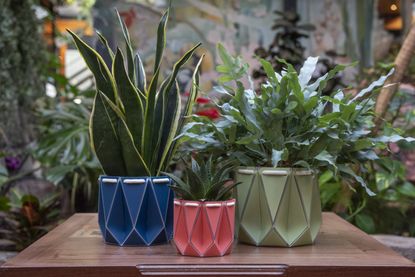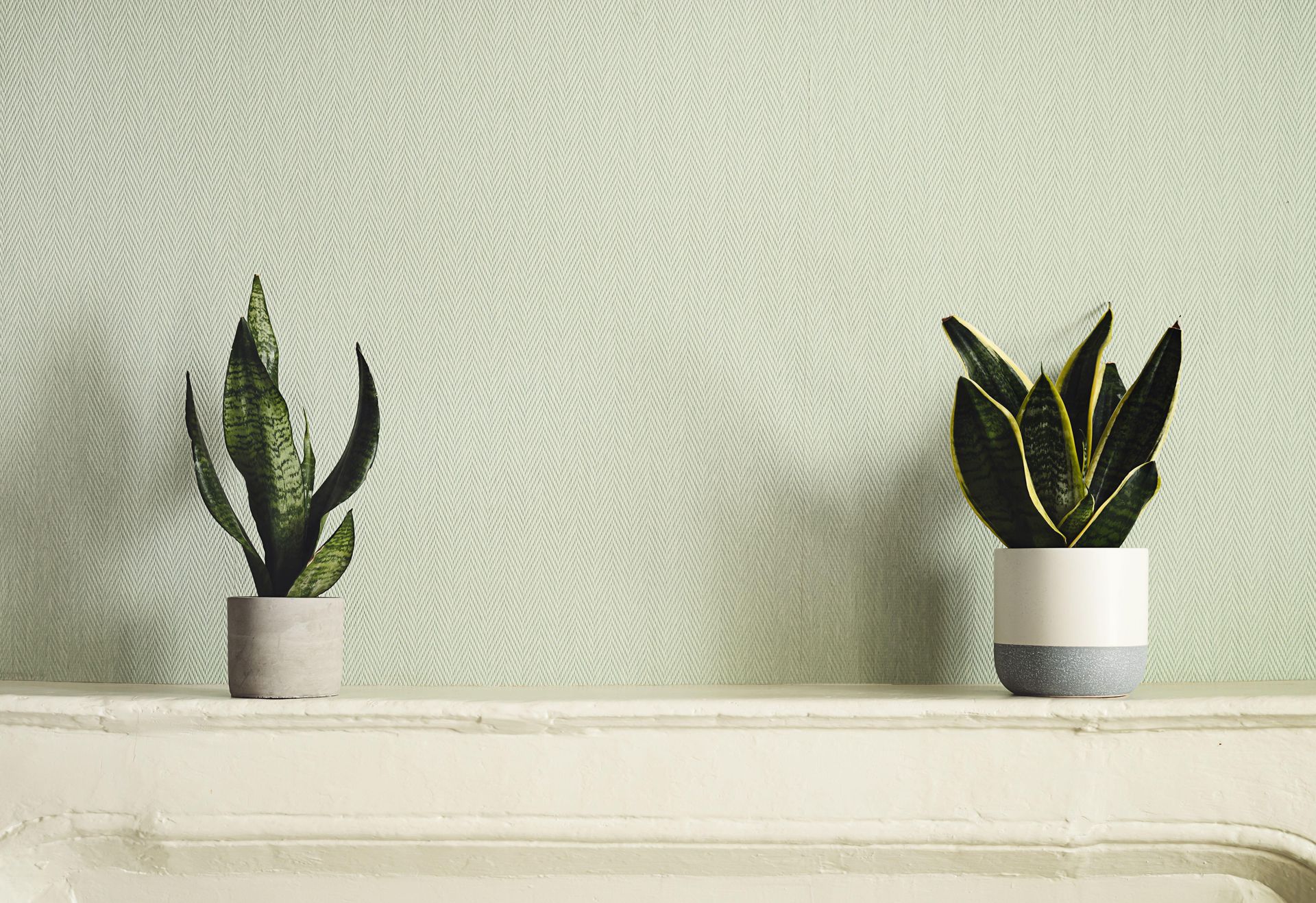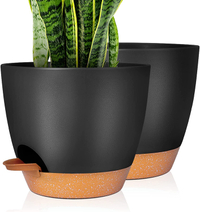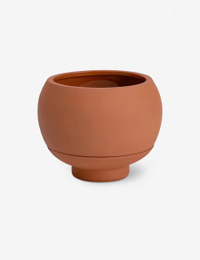Should I invest in a self-watering planter? How this clever, low-tech buy changed my luck with houseplants
Tired of worrying about your houseplants while you're on vacation? Let a self-watering planter be the answer


Do you find it hard to switch off on vacation because you're worried that your houseplants might be dying back at home? (For plant moms like me, it's a genuine concern...) Maybe you're just a serial plant killer who neglects your green-fronded friends. If the answer is yes to either, a self-watering planter might be the solution to your problems.
We all know the aesthetic benefits that plants have to offer but it's easy to forget that, just like us, they have needs that need to be met. To get the most out of your houseplants, they need regular care and constant upkeep, and that includes a strict watering schedule.
For the less green-thumbed among us, that's probably an anxiety-inducing thought. Even the most plant-obsessed people like myself find it hard to maintain adequate plant care all of the time with the daily demands of our modern world, so the idea of a self-watering planter is certainly appealing.
And for some plants, this kind of pot might actually be vitally important. 'When I bought a fiddle leaf fig tree for my living room, it actually came supplied in a self-watering pot,' Livingetc's deputy editor Hugh Metcalf tells me. 'This plant is notoriously hard to keep alive without one, and given it cost over $100, I'd be pretty sick if it died within a few months.'
To help understand what they are and how they work, and the best houseplants to use in them, I asked a few experts to share their insights.

Lilith is an expert at following news and trends across the world of interior design. She regularly shares simple solutions to help brighten our homes, and a personal favorite of hers is houseplants. For this piece she spoke with plant experts to find out how self-watering planters work - the perfect solution to keep your green friends happy while you're away from home.
What are self-watering planters?

As the name suggests, self-watering planters are containers that water your plants using a reserve so you don't have to attend to them as regularly. As Andrew Flynn, co-founder of self-watering plant pot brand POTR, explains: 'Self-watering planters are pots which take care of watering your plants so you don’t have to. They're designed to take the guesswork out of caring for your plants.'
Looking after ourselves is challenging enough at the best of times without having to remember how often you should water your plants. Self-watering planters are a great solution to this. They're an absolute lifesaver for those of us prone to forgetting about - or overwatering - our plant babies. On top of that, they're especially useful for anyone who spends long periods away from home or living between two properties.
How do self-watering planters work?
So, how do they work? All self-watering planters have a space to store water built into their design to feed the plant when it's thirsty. 'They use sub-irrigation, sending water directly to the plant's roots from a reservoir of water at the bottom of the planter, allowing the plant to take when it requires it,' explains Ian Drummond plant expert and author of At Home with Plants, (available at Amazon).
You might be wondering how the pot knows when to send water to the plant - after all, houseplants can't speak for themselves. Contrary to belief, there's actually no hi-tech equipment involved whatsoever. 'Self-watering planters contain a reservoir of water in their base which is connected to the soil surrounding your plant via a wicking cord,' Andrew says. 'The wicking cord acts like straw for your plant whenever it is thirsty, using the science of capillary action to supply your plant with the water it needs, when it needs it.'

Set of 2 self-watering plant pots, Amazon
These clever planters from Amazon have a saucer that's designed to act as a reservoir which can store lots of water at one time. It means your plants can last for a week or even longer without frequent watering! A separate reservoir separates the plant growth environment from the water storage to prevent overwatering or root rot. We love the matt black finish, too!
How often do self-watering planter need filling with water?

While self-watering planters are very clever contraptions and may seem magical, they don't completely eradicate your responsibility. The water reserves cannot replenish themselves, and they thus need filling on a regular basis.
The answer to how often this needs to be done obviously depends on the pot itself, the plant within it, and the natural conditions of the environment. 'A POTR Pot is topped up once every two to three weeks,' Andrew says. 'This is perfect for anyone heading off for some winter sun in the coming weeks and worried about how to care for their beloved green friends while they’re gone.'
Most self-watering containers will sustain themselves for a similar amount of time, and will need topping up more regularly when caring for plants during the summer. Fortunately though, you don't have to play a guessing game when the time comes around; many self-watering plants have a glass water reserve so you can see when it's low. 'Others have an indicator that shows if the reservoir is full, half full, or empty,' adds Ian.
What plants are they best suited for?
Since all plants need water, almost any potted greenery will benefit from a self-watering plant. However, there are some types of houseplants that self-watering methods are best suited for.
'Plants which love a more moist environment such as ferns are particularly well suited to a self-watering planter,' notes Andrew. That means that plants that are usually best in bathrooms and love humidity, such as peace lilies or Boston ferns, do best in a self-watering pot. 'Interestingly, self-watering planters are also perfect for a number of herbs like parsley and mint, so they can be used to grow food at home too!'
Andrew adds: 'The one category we would avoid using these with are succulents. Think of a cactus in a desert - it doesn’t receive rain often and therefore doesn’t like being fed a regular supply of water.'

Sutton Self-Watering Planter, Lulu & Georgia
We love how this planter from Lulu & Georgia pairs functionality with style. The charming ceramic planter by Greenery has a self-watering design that keeps plants healthy from the roots up so you don't have to fret about your houseplants while you jet off on vacation. We love the rustic look of the terracotta paired with the simple yet elegant design.
Can you overwater plants with a self-watering planter?
While lack of water is now a distant concern, it may have just been replaced by a new one: overwatering. Many of us have had plants succumb to the perils of root rot due to too much water, so how does a self-watering planter prevent this from happening? In simple terms, the water supply is kept separate from the actual plant, preventing the roots from drowning.
This is why a wick is used to deliver the water gradually, and this can also be controlled by you as well. 'You can vary the amount of water that transfers to your plant by increasing or decreasing the length of wick cord in the soil,' Andrew explains. 'Therefore, if you’re worried about overwatering, you can start with a short length and increase it over time.'
If you're jetting off abroad this Christmas, why not treat yourself and your plants to a self-watering planter for the holidays? They'll thank you for it on your return home.
Be The First To Know
The Livingetc newsletter is your shortcut to the now and the next in home design. Subscribe today to receive a stunning free 200-page book of the best homes from around the world.

Lilith Hudson is the News Editor at Livingetc, and an expert at decoding trends and reporting on them as they happen. Writing news, features, and explainers for our digital platform, she's the go-to person for all the latest micro-trends, interior hacks, and color inspiration you need in your home. Lilith discovered a love for lifestyle journalism during her BA in English and Philosophy at the University of Nottingham where she spent more time writing for her student magazine than she did studying. After graduating, she decided to take things a step further and now holds an MA in Magazine Journalism from City, University of London, with previous experience at the Saturday Times Magazine, Evening Standard, DJ Mag, and The Simple Things Magazine. At weekends you'll find her renovating a tiny one-up, one-down annex next to her Dad's holiday cottage in the Derbyshire dales where she applies all the latest design ideas she's picked up through the week.
-
 The 12 Best Table Lamps for Reading —I'm a Certified Bookworm (and Shopping Expert)
The 12 Best Table Lamps for Reading —I'm a Certified Bookworm (and Shopping Expert)When it comes to table lamps for reading, I don't mess around. If you're the same, this edit is for YOU (and your books, or course — and good recommendations?)
By Brigid Kennedy Published
-
 "It's Scandi Meets Californian-Cool" — The New Anthro Collab With Katie Hodges Hits Just the Right Style Note
"It's Scandi Meets Californian-Cool" — The New Anthro Collab With Katie Hodges Hits Just the Right Style NoteThe LA-based interior designer merges coastal cool with Scandinavian simplicity for a delightfully lived-in collection of elevated home furnishings
By Julia Demer Published

